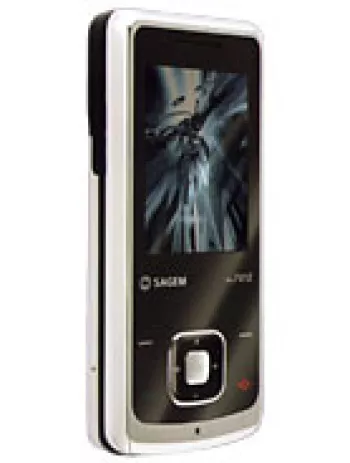
Overview
The Sagem my850C was a product of its time, reflecting both the growing advances in mobile telecommunications technology and the consumer demands of the mid-2000s. Launched in March 2006, this feature phone captured interest with its balanced blend of functionality, design, and price point. As mobile technology has advanced at a rapid pace, revisiting this device provides insight into the evolution of mobile phones and what users expected from their handsets during this period.
Design and Build
The Sagem my850C features a compact design typical of the mid-2000s telefoins. With its dimensions measuring 96 x 49 x 16 mm and weighing just 95 grams, it was a portable option that easily fit into pockets and bags. Its sleek black finish gave it a professional and timeless look, appealing to both personal and business users. Despite its small size, the device was surprisingly sturdy, primarily made out of durable plastic materials that could withstand everyday use.
Display
Boasting a 2.0-inch TFT display, the Sagem my850C offered bright and vibrant visuals with its 256K color screen. With a resolution of 240 x 320 pixels, the display was quite competitive during its release, featuring a picture density of approximately 200 ppi. These specifications allowed for clear visibility, whether making calls, browsing through contacts, or gaming, enabling a user-friendly interaction even in varying light conditions.
Camera
The Sagem my850C included a 2 MP main camera, providing capabilities for basic photography needs. For that era, this was a significant offering, allowing users to capture images with relatively acceptable quality. The device also featured a front-facing VGA camera primarily designed for video calls, making use of the available 3G connectivity.
Network Capabilities
The phone supported both GSM and UMTS technology, featuring 2G bands for GSM 900/1800/1900 and a 3G band for UMTS 2100. This enabled users not only to make calls and send texts but also to enjoy faster data speeds of up to 384 kbps—a notable feature at the time. Such capabilities made the Sagem my850C a versatile choice for users needing reliable connectivity.
Memory and Storage
Internally, the my850C was equipped with 64MB of storage, an acceptable capacity given its classification as a feature phone. For users needing more space for photos, contacts, and other files, the inclusion of a dedicated microSD card slot was crucial, allowing for expanded storage options. The phonebook and call record functionalities were standard, offering room for numerous contacts and a history of recent call activity.
Battery Life
Powering the Sagem my850C was a removable Li-Ion 1000mAh battery, providing a significant standby time of up to 300 hours and a talk time of approximately 3 hours and 30 minutes. These specifications ensured that users could rely on their devices throughout the day without frequent recharging—an advantage for both casual and heavy users.
Connectivity and Communications
The my850C came with Bluetooth 2.0 with A2DP support, providing users with the ability to connect wirelessly to other Bluetooth-enabled devices, such as headsets and printers—a popular feature for hands-free operations. The phone did not include WLAN or GPS, which is common in modern smartphones, but it featured a USB 1.0 port for data transfer and charging purposes. In terms of sound, the device did not have a 3.5mm audio jack or loudspeaker, focusing instead on polyphonic ringtones and vibration alerts.
Additional Features
As a feature phone, the Sagem my850C offered simpler capabilities compared to today’s smartphones. However, it was equipped with several utilities such as messaging options that included SMS, EMS, MMS, and email, serving comprehensive communication needs. The inclusion of a WAP 2.0/xHTML browser provided basic internet browsing, while the Java MIDP 2.0 support allowed for various applications and games to be downloaded and run. These features contributed to an overall enriched user experience, despite the phone's lower technological specifications compared to modern devices.
Conclusion
The Sagem my850C, priced at around 250 EUR during its release, represented a prominent appliance in the mid-2000s mobile market, blending functionality with affordability. While it may not match up to the sophisticated capabilities of current smartphones, it served as an essential communication tool for users at the time, reflecting the technological transition from basic mobile phones to multifunctional smart devices. Understanding and appreciating devices like the Sagem my850C provides perspective on how far mobile technology has evolved in response to ever-changing consumer needs and technological advancements.
Key Features of Sagem my850C
- Supports GSM and UMTS technology.
- 3G capability with UMTS 2100 support.
- Compact dimensions: 96 x 49 x 16 mm, and lightweight at 95 g.
- 2.0-inch TFT display with 256K colors and a resolution of 240 x 320 pixels.
- Expandable storage with microSD card slot.
- 2 MP main camera and VGA videocall camera for selfies.
- Bluetooth 2.0 with A2DP support.
- Messaging options including SMS, EMS, MMS, and Email.
- Java support with MIDP 2.0 for additional applications and games.
- Removable Li-Ion battery with up to 300 hours of standby time.
Disadvantages of Sagem my850C
- Loudspeaker not available.
- No 3.5mm audio jack for standard headphones.
- No WLAN (Wi-Fi) connectivity.
- No built-in GPS for location services.
- No FM Radio feature.
- Limited internal memory of 64MB, although expandable.
- Display's screen-to-body ratio is quite low (~26.3%).
- Lower resolution VGA front camera, limiting selfie and video call quality.
- Relatively low battery talk time (up to 3 hours 30 minutes).
- Device has been discontinued, affecting availability of parts and support.

View Also
More Phones
All Rights Reserved +13916 Phones © Mobilawy 2025

























